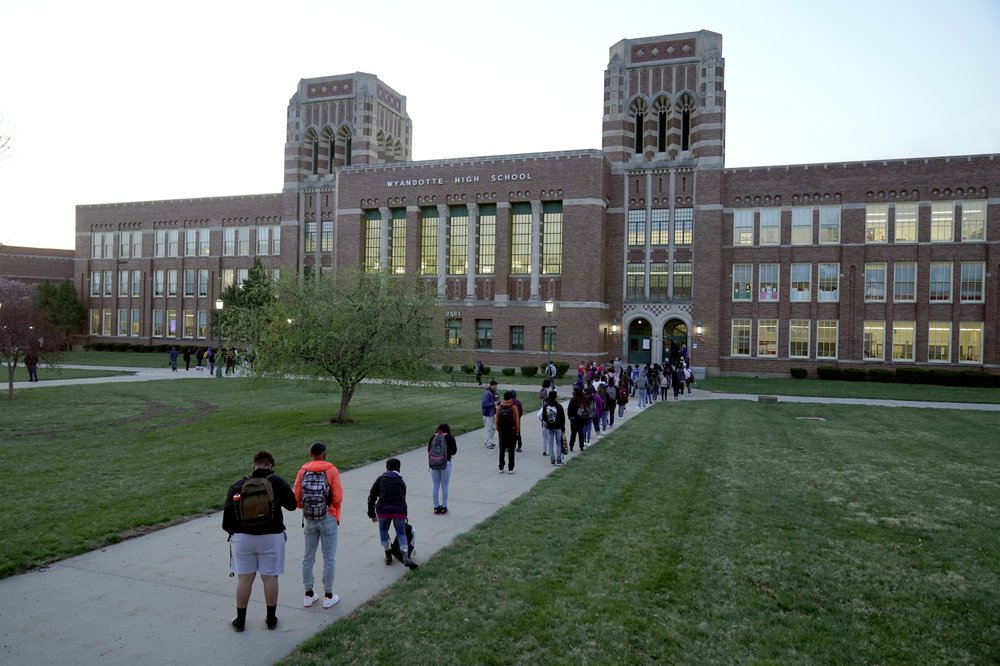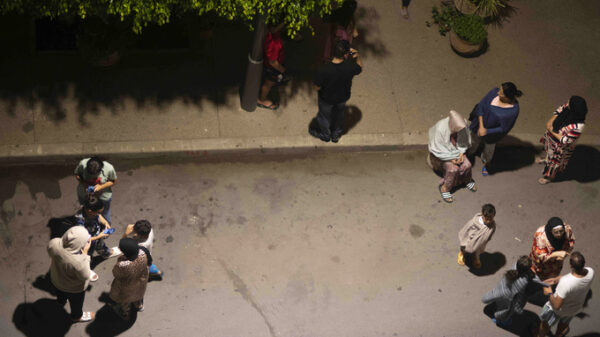FILE – In this Wednesday, March 31, 2021, file photo, students wait to enter Wyandotte County High School in Kansas City, Kan., on the first day of in-person learning. The district was one of the last in the state to return to the classroom after going virtual due to the COVID-19 pandemic. (AP Photo/Charlie Riedel, File)
Large numbers of students are not returning to the classroom even as more schools reopen for full-time, in-person learning, according to a survey released Wednesday by the Biden administration.
The findings reflect a nation that has been locked in debate over the safety of reopening schools during the coronavirus pandemic. Even as national COVID-19 rates continued to ebb in February, key measures around reopening schools barely budged.
Nearly 46% of public schools offered five days a week of in-person to all students in February, according to the survey, but just 34% of students were learning full-time in the classroom. The gap was most pronounced among older K-12 students, with just 29% of eighth graders getting five days a week of learning at school.
There were early signs of a shift, however, with more eighth grade students moving from fully remote to hybrid learning.
With the new findings, President Joe Biden came no closer to meeting his goal of having most elementary schools open five days a week in his first 100 days. Just shy of half the nation’s schools offered full-time learning in February, roughly the same share as the previous month.
Despite the slow progress, federal education officials see it as a step forward.
“There was a decrease in enrollment in remote-only learning and an increase in hybrid instruction at grade eight, providing evidence that more students are walking through school doors again,” Mark Schneider, director of the Education Department’s Institute of Education Sciences, said in a statement.
The findings are based on a survey of 3,500 public schools that serve fourth graders and 3,500 schools that serve eighth graders. It’s based on data from schools in 37 states that agreed to participate. This is the second round of data released from a new survey started by the Biden administration to evaluate progress in reopening schools.
The data capture a month that saw building momentum in the push to reopen schools. In February, the Centers for Disease Control and Prevention declared that schools could safely reopen with masks, social distancing and other precautions. Days later, Biden reframed his goal around reopening schools after critics said his previous pledge lacked ambition.
As in January, the new results showed dramatic disparities based on region and race. In the South, slightly more than half of all fourth graders were learning entirely at school in February, an uptick from the month before. In the same period, by contrast, the Northeast saw a decrease in the rate of students learning in the classroom five days a week, from 23% to 19%.
Overall, more than a third of students in the South and Midwest were learning entirely at school, compared with less than a quarter in the West and Northeast, according to the survey.
White students continued to be far more likely to be back in the classroom, with 52% of white fourth graders receiving full-time, in-person instruction. By contrast, less than a third of Black and Hispanic fourth graders were back at school full time, along with just 15% of Asian students.
The survey does not ask whether students are learning remotely by choice or because their schools do not offer an in-person option. But the wide gulf between school offerings and student learning data suggests that at least some students are opting to stay remote even after their schools reopen classrooms.
It matches previous findings from some of the nation’s largest school districts, where Black students have returned at far lower rates than their white classmates — a disparity that’s believed to come down at least partly to trust. Advocates say more must be done to convince parents that their children will be safe in school, especially Black families who have been disproportionately affected by the coronavirus.
Although wide racial disparities persisted in the new round of data, the Education Department saw a glimmer of hope in a slight increase among Black students learning fully in-person. From January to February, the rate ticked up from 28% to 30%.
“Although white students continue to enroll in full-time in-person instruction at higher rates, we are beginning to see shifts toward full-time in-person learning for other groups,” said Peggy Carr, an associate commissioner at the agency’s National Center for Education Statistics.
Parents across the U.S. have been conflicted about a return to the classroom, expressing concerns about the virus but also about learning setbacks as their children learn remotely, according to a poll from The University of Chicago Harris School of Public Policy and The Associated Press-NORC Center for Public Affairs Research. Worries about learning setbacks were slightly more prevalent than fears of spreading the virus at school, the poll found.
The department also reported progress in bringing more students with disabilities back to school. Among Black and white students with disabilities in the fourth grade, fewer were learning remotely in February than in January, according to the survey.
The survey for the first time collected data on how many teachers have received COVID-19 vaccines, but the findings revealed little. More than half of schools said they did not know how many teachers got at least one shot. Of those with data, just 6% said that between 81% and 100% of their teachers had received a vaccination.
New estimates released by the CDC on Tuesday, however, found that nearly 80% of K-12 employees and child care workers had received at least their first shot by the end of March. Biden said he was pleased with the achievement even though it fell short of his goal to deliver at least one shot to every teacher, school staff member and childcare worker in March.
“That’s great progress protecting our educators, our essential workers,” he said.
Coronavirus vaccines have not been approved for children under 16.
For the first time, the latest round of survey data also included attendance rates for each type of teaching offered in February. The data is meant to cast light on the issue following reports that many districts have seen a rise in absences during the pandemic, both among students learning virtually and students learning in-person.
Nationwide, the survey found that attendance rates were around 90% for all modes of learning. There were slight differences by race, especially at the eighth grade level, where Black students had attendance rates about 5 percentage points below white students in each mode of learning.
Associated Press writer Alexandra Jaffe contributed to this report.
Copyright 2020 Associated Press. All rights reserved.





























